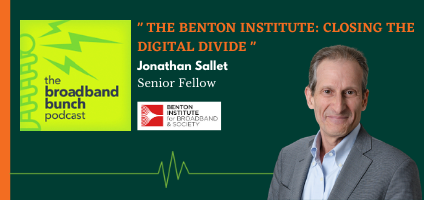

In this episode of the Broadband Bunch, recorded in Washington D.C. at the Broadband Communities event focused on High-Speed Broadband: Driving America’s Growth, we speak with Jon Sallet from the Benton Institute for Broadband Society.
HOW DID YOU END UP WORKING ON BROADBAND POLICY ISSUES?
Jon Sallet: I’ve done telecom issues for a long time. I was in the Clinton administration in the Department of Commerce when we worked on the issues that led to the Telecommunications Act of 1996. I headed the first inter-agency educational technology working group out of the white house. I went to work for MCI in the late ’90s, when there was a lot of talk about competition, long distance and local. Then in 2013, Tom Wheeler, the Chairman of the FCC, asked me to go into the Federal Communications Commission to become its General Counsel, which I did. Then went to the Antitrust Division of Department of Justice where I was the Senior Deputy.
When I left government, I want it to continue to find a way to work on these issues. And Benton has done this for very long time. Is a place that takes the long view about broadband policy, about communications policy. And so I was very grateful for the opportunity to continue my work with them.
THE BENTON INSTITUTE for BROADBAND & SOCIETY – CONNECTING TECHNOLOGY AND COMMUNITIES
Pete Pizzutillo: You mentioned earlier that the Benton Foundation had recently rebranded its name around broadband and society. Can you provide some insight into that motivation?
Jon Sallet: Sure. The Benton Foundation was well known in communication circles, largely through the efforts of Charles Benton, the father of our current Executive Director Adrianne Furniss. But as we came into a new decade, we thought we ought to give people a better understanding of what we do. The word foundation is a pretty general one. So we thought, “Well, is it the Benton Institute for broadband?” And we thought, “No, because somebody will come and ask us how to engineer network, and we won’t know how to do that.” What we’re talking about is the impact that broadband can have on people, on communities. And so we thought the best name was the Benton Institute for Broadband and Society.
FAST, FAIR, OPEN BROADBAND FOR ALL
Pete Pizzutillo: Yeah. Love that connection between the technology and the community that we’re trying to serve. So recently you, as of yesterday, you released the Broadband for America’s Future: A Vision for the 2020s. That’s a pretty audacious plan and report that’s really comprehensive and extensive. And there’s a lot to talk about in there, but if you can help us as, a, what was the motivation for that report? What’s your goal? And what are some of the highlights that you think we should hear about?
Jon Sallet: Sure. It came out of Benton’s past work. This is what Charles Benton had done in the 80s, and then again at the beginning of this century. He sponsored agenda setting exercises, bringing together ideas to try to coalesce thought around key initiatives. Technology is moving fast, society is changing, expectations about broadband are changing. We thought it was time to do that again. And we thought the way to do it was not to pretend like everything was our idea, but to look around the country, at communities, at States, at thought leaders, and pick the best of the best, and illustrate what people know how to do, because we think that’s the foundation for future policy.
So we concentrate on four major areas. First is deployment. How to get broadband to places where there aren’t any. There is none. Secondly, competition. How to make sure consumers get the benefit of competitive broadband services. Thirdly, affordability and adoption. Issues that go together, right? For some low income people, fixed broadband isn’t accessible, in terms of its cost. And many people, more than one might think, lack the digital skills to know how to use broadband. And then finally, community institutions, what we call community anchor institutions. Schools, libraries, hospitals that use broadband to serve their communities.
Pete Pizzutillo: Thank you for that. And one of the, I think, really interesting ideas that you had in there is about the other America, right? And that there’s two Americas. And so it’s a really interesting concept that’s packed with a lot of ideas. Maybe you can help us understand what your thoughts are on that.
Jon Sallet: Yeah. Think about people who don’t have access to fixed broadband at home. They probably have less economic opportunity than other people. Their kids may find it harder to do schoolwork. They may find it harder to get training, harder to get healthcare services in their home. They’re isolated. They can be isolated in an important way. And what we’re saying is, that’s not just a digital divide. A digital divide is the term that’s traditionally been used, and used for good reason. But what we’re saying is that’s really a different America. It’s another America. It’s a place that’s isolated. And particularly in rural locations where people are already physically isolated, they then can be isolated because of lack of fixed broadband alone. It’s a place where people are more likely to rely on community institutions. It’s a place where going to the fast food restaurant is commonplace.
One of the things we heard a lot when we talk to people around the country was, “I take the kids, I put them in a car, I go to the little local McDonald’s and get broadband.” We need to understand that if these people are connected, they will benefit. But we will all benefit because we’ll have the basis for say, a stronger economy.
Pete Pizzutillo: Yeah, no. I think the distinction about… It’s not simply just unplugged, right? It’s disconnected. And I think the report does a great job connecting how these people are lacking the participation in society. They can’t apply for a job online. These things that you just don’t think about, but when your phone dies, you’ve suffered that temporarily. But these are folks that are living in this day-to-day, year-over-year.
Jon Sallet: I told this story yesterday, and it’s in our report. It comes from a woman named Deb Solskjaer who’s led work on digital inclusion for a long time. She’s now in Chattanooga. And we were talking on the phone one day this year and she me, she said, “On two Sundays, I was on business trips. Two Sundays, I was sitting in two fast food restaurants in two different cities. And on each occasion, a man walked in and asked the manager, could he apply for a job using a paper application? And each occasion, the manager said, “No, you have to be online.””
Pete Pizzutillo: It’s crazy.
Jon Sallet: And Deb said to me when we were talking, what does it mean when you can’t flip a burger in America without internet access?
Pete Pizzutillo: Right. That’s crazy. And it’s interesting, because I’ve heard that story a couple times where parents are going to Starbucks for the kids to do homework, and it used to be go to the library to get your homework done. And now they’re going to all these places, these non-traditional, and I think the community-anchoring institutions is kind of… The community is defining them instead of us defining them.
Jon Sallet: Yeah. And the community-anchor institutions, libraries are doing a lot of really good work. There are experiments around the country where people can check out hotspots, wireless hotspots, right? So if their kids can do homework through the hotspots. It’s not a long-term solution, but it can be an important short-term solution.
Pete Pizzutillo: Sure. What about some of the research and educational networks out there, in the Merit Network and some of those other folks?
Jon Sallet: Merit Network in Michigan is just inspiring. It’s an inspiring story, right? It’s inspiring both because as a research and education network, it’s been so successful. But then it’s inspiring because, what they’re doing in Michigan is taking the knowledge, understanding the way middle mile operates, and they’re now working with local communities. They’re not going to supply the local retail service themselves, but they are lending their expertise to local communities that are trying to solve their problems.
I was on a panel a couple of weeks ago with Joe Sawaski, who heads the Merit Network, and he tells a great story about what’s being done in Michigan. But I think even more importantly, what the rest of the country can learn from Michigan.
Pete Pizzutillo: Absolutely. It’s a model. The [Michigan] Moonshot mission that they have, that’s what you’re asking for, right? And essentially is, first off, let’s figure out how big… As you say, the step is getting visibility, right? Let’s not argue that there is a divide. We all know there is a divide. But if we can identify the biggest areas of need, then we can attack the problem starting from there. Right?
Jon Sallet: Yes.
Pete Pizzutillo: And then, I think Moonshot is a great example. We’ve done it for cancer, we’ve done it for the space program. Let’s do it for this, and what I see as broadband as the economic engine, right? And a lot of times, the argument that I hear is, it’s a competing industry against other industries like manufacturing and retail. But it’s really enabling capability. And when do we get to make that connection? I think your report is starting to do that.